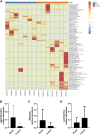Hypericum japonicum extract inhibited porcine epidemic diarrhea virus in vitro and in vivo
- PMID: 37138845
- PMCID: PMC10149974
- DOI: 10.3389/fphar.2023.1112610
Hypericum japonicum extract inhibited porcine epidemic diarrhea virus in vitro and in vivo
Abstract
Porcine epidemic diarrhea virus (PEDV) infection causes lethal watery diarrhea and high mortality in neonatal piglets, leading to huge economic losses in the global swine industry. Currently, the existing commercial vaccines cannot fully control PEDV, so it is urgent to develop effective antiviral agents to complement vaccine therapy. In the present study, we investigated the antiviral effect of Hypericum japonicum extract (HJ) against PEDV in vivo and in vitro. In in vitro assays, HJ could directly inactivate PEDV strains; moreover, it inhibited the proliferation of PEDV strains in Vero or IPI-FX cells at its non-cytotoxic concentrations. Time of addition assays revealed that HJ mainly inhibited PEDV at the later stages of the viral life cycle. In in vivo, compared with the model group, HJ could reduce the viral titers in the intestines of infected piglets, and improve their intestinal pathological, indicating that HJ could protect the newborn piglets from highly pathogenic PEDV variant infection. Furthermore, this effect may be related to the fact that HJ can not only directly inhibit viruses, but also regulate the structure of intestinal microbiota. In conclusion, our results indicate that Hypericum japonicum could inhibit PEDV replication in vitro and in vivo and might possess the potential to develop as the anti-PEDV drug.
Keywords: Hypericum japonicum; antiviral effect; intestinal microbiota; piglets; porcine epidemic diarrhea virus; watery diarrhea.
Copyright © 2023 Rao, Su, Zhang, Wang, Li, Li, Zeng and Li.
Conflict of interest statement
The authors declare that the research was conducted in the absence of any commercial or financial relationships that could be construed as a potential conflict of interest.
Figures











Similar articles
-
Licorice extract inhibits porcine epidemic diarrhea virus in vitro and in vivo.J Gen Virol. 2024 Mar;105(3):001964. doi: 10.1099/jgv.0.001964. J Gen Virol. 2024. PMID: 38471043 Free PMC article.
-
Aloe extract inhibits porcine epidemic diarrhea virus in vitro and in vivo.Vet Microbiol. 2020 Oct;249:108849. doi: 10.1016/j.vetmic.2020.108849. Epub 2020 Sep 15. Vet Microbiol. 2020. PMID: 32979750 Free PMC article.
-
Quantitative Proteomic Analysis Reveals Antiviral and Anti-inflammatory Effects of Puerarin in Piglets Infected With Porcine Epidemic Diarrhea Virus.Front Immunol. 2020 Feb 26;11:169. doi: 10.3389/fimmu.2020.00169. eCollection 2020. Front Immunol. 2020. PMID: 32174911 Free PMC article.
-
Porcine epidemic diarrhea virus infection: Etiology, epidemiology, pathogenesis and immunoprophylaxis.Vet J. 2015 May;204(2):134-43. doi: 10.1016/j.tvjl.2015.02.017. Epub 2015 Feb 26. Vet J. 2015. PMID: 25841898 Free PMC article. Review.
-
Porcine epidemic diarrhea virus: Molecular mechanisms of attenuation and vaccines.Microb Pathog. 2020 Dec;149:104553. doi: 10.1016/j.micpath.2020.104553. Epub 2020 Oct 1. Microb Pathog. 2020. PMID: 33011361 Free PMC article. Review.
Cited by
-
Advances research in porcine enteric coronavirus therapies and antiviral drugs.Vet Q. 2024 Dec;44(1):1-49. doi: 10.1080/01652176.2024.2421299. Epub 2024 Nov 1. Vet Q. 2024. PMID: 39484691 Free PMC article. Review.
-
Quercetin inhibition of porcine intestinal alpha coronavirus in vitro and in vivo.BMC Vet Res. 2024 Apr 3;20(1):134. doi: 10.1186/s12917-024-03984-2. BMC Vet Res. 2024. PMID: 38570774 Free PMC article.
-
Screening of Active Compounds Against Porcine Epidemic Diarrhea Virus in Hypericum japonicum Thunb. ex Murray Extracts.Viruses. 2025 Jun 26;17(7):900. doi: 10.3390/v17070900. Viruses. 2025. PMID: 40733517 Free PMC article.
-
An overview of natural herbal extracts and compounds for combating porcine epidemic diarrhea virus.Front Vet Sci. 2025 Jun 6;12:1557198. doi: 10.3389/fvets.2025.1557198. eCollection 2025. Front Vet Sci. 2025. PMID: 40548251 Free PMC article. Review.
-
Licorice extract inhibits porcine epidemic diarrhea virus in vitro and in vivo.J Gen Virol. 2024 Mar;105(3):001964. doi: 10.1099/jgv.0.001964. J Gen Virol. 2024. PMID: 38471043 Free PMC article.
References
-
- Chen J., Mao Y., Xing C., Hu R., Xu Z., Cao H., et al. (2020). Traditional Chinese medicine prescriptions decrease diarrhea rate by relieving colonic inflammation and ameliorating caecum microbiota in piglets. Evid. Based Complement. Altern. Med. 2020, 3647525. 10.1155/2020/3647525 - DOI - PMC - PubMed
LinkOut - more resources
Full Text Sources

